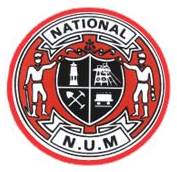Related Research Articles

The National Union of Mineworkers (NUM) is a trade union for coal miners in Great Britain, formed in 1945 from the Miners' Federation of Great Britain (MFGB). The NUM took part in three national miners' strikes, in 1972, 1974 and 1984–85. After the 1984–85 strike and the subsequent closure of most of Britain's coal mines, it became a much smaller union. It had around 170,000 members when Arthur Scargill became leader in 1981, a figure which had fallen in 2015 to an active membership of around 100.
The Miners' Federation of Great Britain (MFGB) was established after a meeting of local mining trade unions in Newport, Wales in 1888. The federation was formed to represent and co-ordinate the affairs of local and regional miners' unions in England, Scotland and Wales whose associations remained largely autonomous. At its peak, the federation represented nearly one million workers. It was reorganised into the National Union of Mineworkers in 1945.

The South Wales Miners' Federation (SWMF), nicknamed "The Fed", was a trade union for coal miners in South Wales. It survives as the South Wales Area of the National Union of Mineworkers.
Lawrence Daly was a coal miner, trade unionist and political activist.

The National Union of Scottish Mineworkers (NUSW) is a trade union in Scotland, founded in 1894 as the Scottish Miners Federation. It joined the Miners' Federation of Great Britain, and in 1914 changed its name to National Union of Scottish Mineworkers. It survives as the National Union of Mineworkers.
The Lancashire and Cheshire Miners' Federation (LCMF) was a trade union that operated on the Lancashire Coalfield in North West England from 1881 until it became the Lancashire area of the National Union of Mineworkers in 1945.
The Midland Counties Miners' Federation was a trade union, representing coal miners in the West Midlands region of England.
The Northern Rhodesian African Mineworkers' Union (A.M.U.) was a trade union in Northern Rhodesia which represented black African miners in the Copperbelt. The AMU was formed in 1949, and campaigned actively to improve working conditions and wages for African miners, as well as opposing racial discrimination in hiring. The union amalgamated with several other mining unions in 1967 to form the Mineworkers' Union of Zambia.
The Cumberland Miners' Association was a trade union in the United Kingdom.
The North Midlands Rugby Football Union is a governing body for rugby union in part of The Midlands, England. The union is the constituent body of the Rugby Football Union for the counties of Herefordshire, Shropshire, Worcestershire and the Greater Birmingham area.
The West Yorkshire Miners' Association (WYMA) was an early British trade union representing coal miners in the central part of the West Riding of Yorkshire.
William Brown was a British coal miner who became a prominent trade unionist.
The Warwickshire Miners' Association was a trade union representing coal miners in the Warwickshire area of England.
The Pelsall District Miners' Association was a trade union representing coal miners in the Walsall area of England.
The North Staffordshire Miners' Federation was a trade union representing miners in the area of Stoke-on-Trent, located in Staffordshire, in England.
The West Bromwich Miners' Association was a trade union representing coal miners in southern Staffordshire and eastern Worcestershire, in the United Kingdom.
The National Federation of Colliery Officials was a trade union representing colliery workers in the United Kingdom who were not involved in manual labour.
John Taylor was a British trade unionist and politician.
Henry Rust was a British trade unionist.
The Shropshire Miners', Enginemen's and Surfacemen's Federation, often known as the Shropshire Miners' Association, was a trade union representing coal miners in Shropshire, in England.
References
- 1 2 3 4 5 Eric Taylor, "Winwood, Benjamin", Dictionary of Labour Biography, vol.II, pp.409–413
- ↑ Gregory, Roy (1968). The Miners and British Politics 1906-1914. Oxford: Oxford University Press. p. 168.
- ↑ National Union of Mineworkers, "Annual Conference 1946: Report of the National Executive Committee", p.98